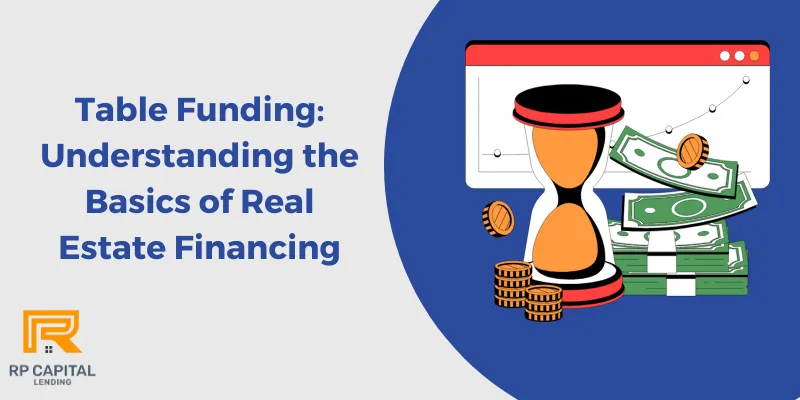Blog

What Is Table Funding? Definition, Benefits, and How It Works
Imagine a real estate closing process so refined that buyers, sellers, and lenders align perfectly, culminating in a transaction that is completed within mere hours. This ideal scenario isn't just a dream—it's a reality made possible through table funding.
In this detailed guide, we delve into the mechanics of table funding, exploring its advantages, challenges, and the best practices for ensuring a smooth and efficient process.
What is Table Funding?

Table funding is a financing method used predominantly in private lending, where the loan is funded by a third-party lender at the time of closing.
This approach is popular among hard money lenders and bridge lenders, especially those involved in real estate investment loans.
It allows loan originators to manage the entire loan process without using their own capital, while still maintaining control over the borrower relationship.
How Table Funding Works?
In a typical table funding transaction, the loan originator (which can be a broker or correspondent lender) initiates the loan process and appears as the lender in the loan documentation.
However, the funds required to close the loan come from a third-party lender. This is done seamlessly at the "closing table," giving the appearance that the originator is funding the loan.
Here's a breakdown of the process:
Loan Origination:
The loan originator handles the loan process, including finding the borrower and performing underwriting.
Third-Party Lender:
A third-party lender provides the actual funds at closing.
Closing and Assignment:
The loan is funded by the third-party lender at closing, and immediately after, the loan is assigned to the third-party lender. The borrower may not even be aware of this process.
This method is sometimes referred to as wholesale lending or white label lending because the originator maintains the borrower relationship while using the funds from another entity.
Why Table Funding is Beneficial for Private Lenders?

Table funding offers several key benefits that make it attractive to private lenders:
1. Efficient Use of Capital:
Lenders do not need to tie up their own funds in each loan. This allows them to focus their resources on originating more loans, growing their portfolio, and expanding their business.
2. Focus on Core Business:
By outsourcing the funding aspect, private lenders can concentrate on identifying and structuring loans, while leaving capital management and operational tasks to the third-party lender.
3. Risk Sharing:
In many cases, third-party lenders assume much of the financial risk, especially in the event of a default.
4. Scalability:
Private lenders can increase their loan volume without needing to raise more capital, allowing them to grow their business faster.
Differences Between Table Funding and Other Lending Models
Table funding differs from other lending models like correspondent lending and direct lending:
In correspondent lending, the lender funds the loan with their own capital but sells it to a larger institution after closing.
In direct lending, the lender provides the capital from its own resources throughout the process.
With table funding, the loan originator acts as the lender without using their own funds, which makes this model a more flexible and capital-efficient option.
Table Funding in Real Estate Investment
Table funding is commonly used in real estate investment loans, particularly for fix-and-flip projects and long-term rental properties. It allows private lenders to provide financing solutions that meet the evolving needs of real estate investors. Since the originator maintains the borrower relationship, they can continue to serve the borrower even as the financing needs change, such as transitioning from short-term fix-and-flip loans to long-term rental loans.
This flexibility helps private lenders retain their clients and offer a range of financial solutions without requiring borrowers to seek out different lenders for various loan types.
How to Find Table Funding Providers
There are various table funding providers available, some of whom charge points for providing funds, while others—typically institutional lenders—may offer table funding without charging points for loans below certain amounts, such as $1.5 million. Identifying the right funding partner is essential for lenders looking to scale their business and operate efficiently.
Conclusion
Table funding is an excellent strategy for private lenders looking to scale their operations without using their own capital. It allows them to focus on originating loans, building relationships with borrowers, and growing their business, while the third-party lender handles the financial and operational aspects of loan servicing.
By utilizing table funding, private lenders can expand their lending activities, maintain strong borrower relationships, and share the risks associated with loan defaults—all without the need for significant capital investment.
FAQs:
Q1: How can I ensure a smooth table funding process?
Preparation is key. Ensure all documentation is complete and verified prior to the closing. Also, confirm all parties understand their roles and the timing of the transaction.
Q2: What happens if a party fails to meet their obligations at the closing table?
Contingencies should be in place, such as legal clauses in contracts that address potential failures to perform, ensuring protection for all parties.
Q3: Are there specific types of properties or transactions where table funding is more advantageous?
Table funding is particularly advantageous in transactions requiring quick turnarounds, such as auction properties or distressed sales.
Q4: Can table funding be combined with other funding methods?
Yes, it can be combined with traditional funding methods for the initial deposit or down payments, with table funding used for the final transaction stage.
Q5: How do market conditions affect table funding?
In a volatile market, the immediate nature of table funding can be beneficial, locking in prices and reducing the risk associated with funding delays.
Also Read:
The Ultimate Guide to Private Lending Interest Rates in 2024
Hard Money Loans in the US: Your Ultimate Guide
What Does Cash Only Mean In Real Estate?
RP Capital Lending is a d.b.a of RP Capital Partners Inc (NMLS # 2469193) | Privacy Policy
Copyright © 2022. All Rights Reserved.
Disclaimer: Loans only apply to non-owner occupied properties. Rates, terms and conditions offered only to qualified borrowers, may vary upon loan product, deal structure, other applicable considerations, and are subject to change at any time without notice.

